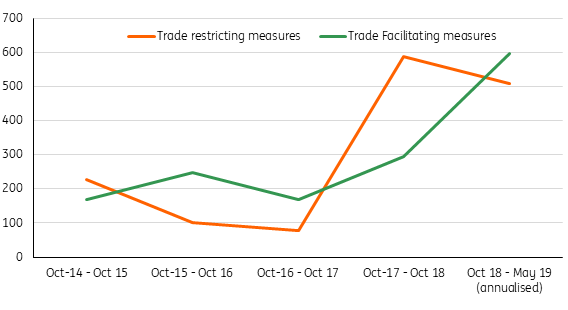Strong trade liberalisation despite trade war
While the US-China trade war has raised fears about a return to protectionism, trade liberalisation in the rest of the world is surprisingly high. Still, we think trade tensions will probably escalate this year and the value of trade flows affected by restrictive import measures is likely to rise
New WTO data shows a steep rise in trade liberalisation. On an annualised basis, trade flows subject to liberalised measures are now three times higher than before the start of the trade war, outpacing restrictive measures (see chart).
The Trade Facilitation Agreement (TFA) of 2017 and the Pacific Trade Agreement CPA-TPP are now largely ratified, pushing up the amount of trade flows covered by liberalised measures (see chart).
New import tariffs, which are part of the US trade dispute with China, make up the bulk of the restrictive trade measures.
Trade flows affected by restricting and facilitating measures US$bn

Trade liberalisation is expected to continue as new trade agreements are due to be implemented:
- A trade deal between the EU and Singapore was signed at the end of last year
- An EU-Vietnam trade agreement was signed three weeks ago
- The EU trade agreement with the South American Trading block MERCOSUR (including Brazil and Argentina) is expected to be signed shortly.
Nevertheless, we think a further escalation of the US-China trade war will overshadow these new efforts to liberalise trade. This doesn’t bode well for world trade, with forward looking trade indicators such as PMIs and IATA flight data already below trend.
This publication has been prepared by ING solely for information purposes irrespective of a particular user's means, financial situation or investment objectives. The information does not constitute investment recommendation, and nor is it investment, legal or tax advice or an offer or solicitation to purchase or sell any financial instrument. Read more
Download
Download snap